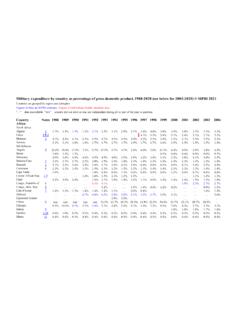Transcription of Trends in world military expenditure, 2020
1 world military expenditure in 2020 is estimated to have been $1981 billion, the highest level since 1988 the earliest year for which SIPRI has a consist-ent estimate for total global military spending. world military expenditure in 2020 was per cent higher in real terms than in 2019 and per cent higher than in 2011 (see figure 1). The global military burden world military expenditure as a share of global gross domestic product (GDP) rose by percentage points in 2020, to per cent. This increase was largely due to the fact that most countries in the world experienced severe economic down-turns in 2020 related to the Covid-19 pandemic, while military expenditure continued to rise overall (see box 1).This Fact Sheet highlights the regional and national military expenditure data for 2020 and Trends over the decade 2011 20.
2 The data is from the updated open-access SIPRI military expenditure Database, which provides military spending data by country for the years 1949 FACTSw world military expenditure was $1981 billion in 2020, an increase of per cent on 2019 in real Total military spending accounted for per cent of global gross domestic product (GDP) in The five biggest spenders in 2020 were the United States, China, India, Russia and the United Kingdom, which together accounted for 62 per cent of world military spending. w US military expenditure grew by per cent in 2020, to $778 billion. China ( per cent), India ( per cent), Russia ( per cent) and the UK ( per cent) all increased their military spending in In 2020 military expenditure increased in Africa ( per cent), Europe ( per cent), the Americas ( per cent), and Asia and Oceania ( per cent).
3 The total military expenditure of the 11 countries in the Middle East for which data is available decreased by per The military burden increased across all regions in 2020. The military burden was an average of per cent of GDP for countries in the Americas; per cent for Africa, Asia and Oceania, and Europe; and per cent for the countries in the Middle East for which data is Fact SheetApril 2021 Trends IN world military expenditure , 2020diego lopes da silva, nan tian and alexandra marksteiner Figure 1. world military expenditure , by region, 1988 2020 Notes: The absence of data for the Soviet Union in 1991 means that no total can be calculated for that estimates for the Middle East are included in the world totals for 2015 : SIPRI military expenditure Database, Apr.
4 expenditure (constant 2019 US$ billion) 05001 0001 5002 0001990199520002005201020152020 Middle EastEuropeAsia and OceaniaAmericasAfrica2 sipri fact sheetTable 1. The 40 countries with the highest military expenditure in 2020 Spending figures and GDP are in US dollars, at current prices and exchange rates. Changes are in real terms, based on constant (2019) US dollars. Percentages below 10 are rounded to 1 decimal place; those over 10 are rounded to whole numbers. Figures and percentage shares may not add up to stated totals or subtotals due to the conventions of ($ b.), 2020 Change (%) Spending as a share of GDP (%)bWorld share (%), 202020202019a2019 202011 202020201111 United [252] [ ][ ][13] top 51 224..6265 Saudi Arabia[ ] [ ][ ][ ] top 101 482.
5 Top 151 603.. ( ) ( )( )( ) [ ] [11][ ][ ] [ ]11198[ ][ ][ ] top 401 827..92 World1 . = data not available or not applicable; ( ) = uncertain estimate; [ ] = SIPRI estimate; GDP = gross domestic Rankings for 2019 are based on updated military expenditure figures in the current edition of the SIPRI military expenditure Database. They may therefore differ from the rankings for 2019 given in SIPRI Yearbook 2020 and in other SIPRI publications in 2020. b The figures for military expenditure as a share of GDP are based on estimates of 2020 GDP from the International Monetary Fund world Economic Outlook and International Financial Statistics : SIPRI military expenditure Database, Apr. 2021; International Monetary Fund, world Economic Outlook Database, Oct.
6 2020; and International Monetary Fund, International Financial Statistics Database, Sep. in world military expenditure , 2020 3 THE TOP 15 military SPENDERS IN 2020 military expenditure by the top 15 countries reached $1603 billion in 2020 and accounted for 81 per cent of global military spending (see table 1). There were some changes in the composition and rank order of the top 15 between 2019 and 2020. Most notably, Israel entered the top 15 in place of Turkey, and the United Kingdom moved above Saudi Arabia whose military spending fell by 10 per cent to become the fifth largest spender in but three countries in the top 15 had higher military expenditure in 2020 than in 2011. The exceptions were the United States ( 10 per cent), the UK ( per cent) and Italy ( per cent).
7 China s increase in military spending of 76 per cent was by far the largest among the top 15 over the decade 2011 20. Other top 15 countries with substantial increases between 2011 and 2020 were South Korea (41 per cent), India (34 per cent), Australia (33 per cent) and Israel (32 per cent).With a military budget of an estimated $778 billion, the USA remained the world s largest spender in 2020, accounting for 39 per cent of global mili-tary spend ing (see figure 2). In 2020 the USA spent almost as much on its mili tary as the next 12 largest spenders combined. The US military burden amounted to per cent of GDP in 2020, up by percentage points on the previous military expenditure in 2020 was per cent higher than in 2019.
8 The 2020 financial year was the third consecutive year of growth in US military spending, following continuous real-terms decreases between 2010 when US spending peaked and 2017. The increases in the financial years covering 2018 20 can be attributed to focused investment in research and develop-ment, and implementation of several long-term projects such as moderniz ing the US nuclear arsenal and large-scale arms pro cure ment. The main drivers of the increases in recent years were perceived threats to the USA from strategic competi-tors such as China and Russia and the push by former US President Donald J. Trump to build up what he saw as a depleted , the world s second larg-est military spender in 2020, is estimated to have accounted for 13 per cent of the global total.
9 The $252 billion spent on the military in 2020 was per cent higher than in 2019 and amounted to per cent of GDP. China s mili-tary expenditure has increased for 26 consecutive years. This growth is the result of China s long-term military modernization and expansion process. According to China s Ministry of National Figure 2. The share of world military expenditure of the 15 countries with the highest spending in 2020 Source: SIPRI military expenditure Database, Apr. Korea Arabia sipri fact sheetDefense, the increase in 2020 was in part motivated by perceived threats to China s national security related to power politics .At $ billion, India s military spending in 2020 was per cent higher than in 2019 and 34 per cent higher than in 2011.
10 This increase can be largely attributed to India s ongoing conflict with Pakistan over Kashmir and renewed border tensions with China, as well as India s more general rivalry with China as the main regional power in Asia and Oceania. Russia s military expenditure was $ billion in 2020, per cent higher than in 2019 and 26 per cent higher than in 2011. The increases in Russian spending in 2019 and 2020 followed decreases in 2017 and 2018. Before 2017, Russia s military spending had risen for 18 straight years. Although Russia s military spending grew overall in 2020, the economic consequences of the Covid-19 pandemic appeared to have an immediate impact: Russia s actual military spending in 2020 was per cent lower than its initial military expenditure by North Atlantic Treaty Organization (NATO) members totalled $1103 billion in 2020.








